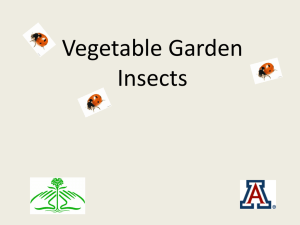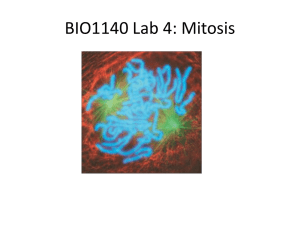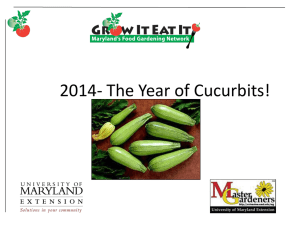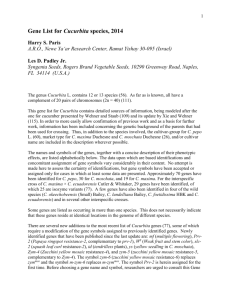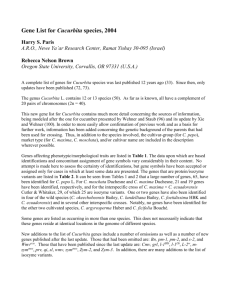Thursday Lecture – Fruits and Nuts of Warm Regions
advertisement
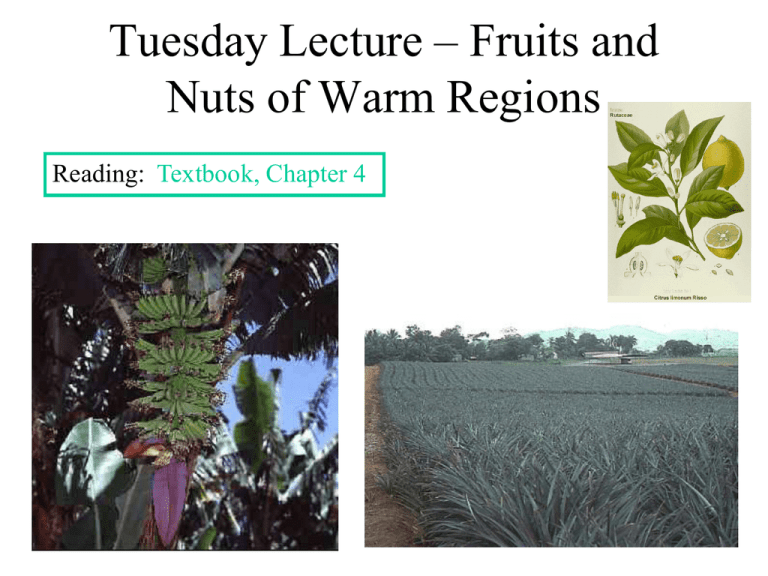
Tuesday Lecture – Fruits and Nuts of Warm Regions Reading: Textbook, Chapter 4 OPTIONAL ASSIGNMENT What are the tropics? - define and explain this term, especially as it applies to the factors that affect the growth of plants, including economically important ones. Due today - return as hard copy or by e-mail QUIZ 1. Name a fruit that is from a member of the rose family, Rosaceae. 2. A hesperidium is a type of berry – how is it different from other berries? Give an example of a hesperidium. Orangerie Kumquat – Fortunella japonica and F. margarita Cucurbitaceae – Squashes and their Relatives Many genera used for food; some also for various implements Fruit = pepo --- a berry with a hard rind ( enhances storage) Cucurbitaceae – Squashes and their Relatives Many genera used for food; some also for various implements Fruit = pepo --- a berry with a hard rind ( enhances storage) Plants = vines, with tendrils Cucurbitaceae – Squashes and their Relatives Many genera used for food; some also for various implements Fruit = pepo --- a berry with a hard rind ( enhances storage) Plants = vines, with tendrils Flowers – often unisexual, with 5 sepals, 5 united petals Cucurbita Flowers See Fig. 4.5, p. 83 Cucurbita Flowers See Fig. 4.5, p. 83 Pistillate (“female”) Flower (note enlarged ovary at base) Cucurbita Flowers See Fig. 4.5, p. 83 Pistillate (“female”) Flower Staminate (“male”) Flower (note slender stalk) Cucurbita Flowers See Fig. 4.5, p. 83 Pistillate (“female”) Flower Staminate (“male”) Flower Cucurbita Flowers See Fig. 4.5, p. 83 Pistillate (“female”) Flower Staminate (“male”) Flower Cultivated Cucurbita Species Squashes See Table 4.3, p. 84 C. pepo – summer squash, zucchini, etc. Cultivated Cucurbita Species Squashes See Table 4.3, p. 84 C. pepo – summer squash, zucchini, etc. C. moschata – winter squash, butternut squash, pumpkin Cultivated Cucurbita Species Squashes See Table 4.3, p. 84 C. pepo – summer squash, zucchini, etc. C. moschata – winter squash, butternut squash, pumpkin C. maxima – winter squash, pumpkin Cultivated Cucurbita Species Squashes See Table 4.3, p. 84 C. pepo – summer squash, zucchini, etc. C. moschata – winter squash, butternut squash, pumpkin C. maxima – winter squash, pumpkin C. argyrosperma – winter squash, hubbard squash etc. Cultivated Cucurbita Species Squashes See Table 4.3, p. 84 C. pepo – summer squash, zucchini, etc. C. moschata – winter squash, butternut squash, pumpkin C. maxima – winter squash, pumpkin C. argyrosperma – winter squash, hubbard squash etc. First uses – probably for seeds; later used for fleshy part of fruit Cultivated Cucurbita Species Squashes See Table 4.3, p. 84 C. pepo – summer squash, zucchini, etc. C. moschata – winter squash, butternut squash, pumpkin C. maxima – winter squash, pumpkin C. argyrosperma – winter squash, hubbard squash etc. All New World Species Cultivated Cucurbita Species Squashes See Table 4.3, p. 84 C. pepo – summer squash, zucchini, etc. C. moschata – winter squash, butternut squash, pumpkin C. maxima – winter squash, pumpkin C. argyrosperma – winter squash, hubbard squash etc. All New World Species - separate domestications – eastern North America, Mexico, of C. pepo Other Cultivated Cucurbits Old World: - Watermelon – Citrullus lanatus - Melons – Cucumis melo - Cucumbers – Cucumis sativus Luffa – Luffa cylindrica Other Cultivated Cucurbits Old World: - Watermelon – Citrullus lanatus - Melons – Cucumis melo - Cucumbers – Cucumis sativus Luffa – Luffa cylindrica New World: - Chayote – Sechium edule Other Cultivated Cucurbits Old World: - Watermelon – Citrullus lanatus - Melons – Cucumis melo - Cucumbers – Cucumis sativus Luffa – Luffa cylindrica New World: - Chayote – Sechium edule Global: - Bottle Gourd – Lagenaria siceraria Bottle Gourds – evidence of preColumbian contact? Archaeological Record: cultivated in Ecuador/Peru (7,000 years ago) and Egypt (3000 years ago) Resolution: - people in reed boats? Fishermen? - gourds floating in oceanic currents? Bottle Gourds – evidence of preColumbian contact? Erickson et al. PNAS 2005 102: 18315-18320 Resolution: (1) Discovery of truly wild bottle gourd in Africa Bottle Gourds – evidence of preColumbian contact? Erickson et al. PNAS 2005 102: 18315-18320 Resolution: (1) Discovery of truly wild bottle gourd in Africa (2) Accurate identification of New World archeological samples - fruit wall thickness, cellular structure, phytoliths Bottle Gourds – evidence of preColumbian contact? Erickson et al. PNAS 2005 102: 18315-18320 Resolution: (1) Discovery of truly wild bottle gourd in Africa (2) Accurate identification of New World archeological samples - fruit wall thickness, cellular structure, phytoliths (3) Accurate dating of material using direct AMS C14 technology - Florida (8100 yrs); Peru (8400 yrs); Mexico (10,000 yrs BP) Bottle Gourds – evidence of preColumbian contact? Erickson et al. PNAS 2005 102: 18315-18320 Resolution: (1) Discovery of truly wild bottle gourd in Africa (2) Accurate identification of New World archeological samples - fruit wall thickness, cellular structure, phytoliths (3) Accurate dating of material using direct AMS C14 technology - Florida (8100 yrs); Peru (8400 yrs); Mexico (10,000 yrs BP) (4) DNA markers -> New World matches Asia, not Africa Bottle Gourds – evidence of preColumbian contact? Erickson et al. PNAS 2005 102: 18315-18320 Resolution: (1) Discovery of truly wild bottle gourd in Africa (2) Accurate identification of New World archeological samples - fruit wall thickness, cellular structure, phytoliths (3) Accurate dating of material using direct AMS C14 technology - Florida (8100 yrs); Peru (8400 yrs); Mexico (10,000 yrs BP) (4) DNA markers -> New World matches Asia, not Africa Conclusion: dog + gourds moved with early people from Asia Adventures in Etymology – Love Apples Tomato – New World crop Adventures in Etymology – Love Apples Tomato – New World crop - 1544 (Matthiolus herbal: pomo d’oro = golden apple) Adventures in Etymology – Love Apples Tomato – New World crop - 1544 (Matthiolus herbal: pomo d’oro = golden apple) - possible transit: New World Spain (ignored) Morocco Italy (pomo dei moro = Moor’s apple) Adventures in Etymology – Love Apples Tomato – New World crop - 1544 (Matthiolus herbal: pomo d’oro = golden apple) - possible transit: New World Spain (ignored) Morocco Italy (pomo dei moro = Moor’s apple) - France, name transformed to pomme d’amour = love apple Adventures in Etymology – Love Apples Tomato – New World crop - 1544 (Matthiolus herbal: pomo d’oro = golden apple) - possible transit: New World Spain (ignored) Morocco Italy (pomo dei moro = Moor’s apple) - France, name transformed to pomme d’amour = love apple Early confusion in Europe/North America: - aphrodisiac (love apple) - poisonous (association with related plants of Solanaceae) Adventures in Etymology – Love Apples Tomato – New World crop - 1544 (Matthiolus herbal: pomo d’oro = golden apple) - possible transit: New World Spain (ignored) Morocco Italy (pomo dei moro = Moor’s apple) - France, name transformed to pomme d’amour = love apple Early confusion in Europe/North America: - aphrodisiac (love apple) - poisonous (association with related plants of Solanaceae) Note: German name “wolf peach” (association with werewolves) became basis for genus name Lycopersicon Tomato Wild ancestors of tomato – Peru and Galapagos Islands Tomato Wild ancestors of tomato – Peru and Galapagos Islands Find Peru and the Galapagos Islands on the globe Tomato Wild ancestors of tomato – Peru and Galapagos Islands Domestication – seems to have occurred in Mexico: Mayan name, xtomatl or tomatl Spanish tomate tomato Tomato Wild ancestors of tomato – Peru and Galapagos Islands Domestication – seems to have occurred in Mexico: Mayan name, xtomatl or tomatl Spanish tomate tomato Classification: Traditional – distinct genus, Lycopersicon Tomato Wild ancestors of tomato – Peru and Galapagos Islands Domestication – seems to have occurred in Mexico: Mayan name, xtomatl or tomatl Spanish tomate tomato Classification: Traditional – distinct genus, Lycopersicon New Molecular-based Findings – part of Solanum (actually sister group to potatoes) Tomato – Flower and Fruit See Fig. 4.11, p. 90 Notes: Stamens open by terminal pores require shaking to release pollen Tomato – Flower and Fruit See Fig. 4.11, p. 90 Notes: Stamens open by terminal pores require shaking to release pollen Plants are quite sensitive to chemicals produced by walnuts (allelopathy) Tomatoes – Modification under Domestication Cherry-tomato type – 2 carpels in ovary Fruit type = ? Tomatoes – Modification under Domestication Cherry-tomato type – 2 carpels in ovary Fruit type = berry Tomatoes – Modification under Domestication Cherry-tomato type – 2 carpels in ovary Intruded placentae Tomatoes – Modification under Domestication Cherry-tomato type – 2 carpels in ovary Intruded placentae Colorful tomatoes Pineapples – The Multiple Fruit Ananas comosus Bromeliaceae See Fig. 4.16, p. 93 What is a Cereal? What is a Cereal? Ceres – Roman goddess of agriculture (in Greek, Demeter). Myth: mother of Persephone, who was kidnapped by Hades; Ceres went on strike to demand return of daughter; Persephone had eaten a pomegranate seed forced to divide time – explanation for temperate seasons What is a Cereal? Ceres – Roman goddess of agriculture (in Greek, Demeter). Myth: mother of Persephone, who was kidnapped by Hades; Ceres went on strike to demand return of daughter; Persephone had eaten a pomegranate seed forced to divide time – explanation for temperate seasons Grain = seeds/seedlike fruits of plants, particularly grasses See Fig. 5.1, p. 111 What is a Cereal? Ceres – Roman goddess of agriculture (in Greek, Demeter). Myth: mother of Persephone, who was kidnapped by Hades; Ceres went on strike to demand return of daughter; Persephone had eaten a pomegranate seed forced to divide time – explanation for temperate seasons Grain = seeds/seedlike fruits of plants, particularly grasses Cereal = edible grains produced by annual grasses Cereal Grain – redundant? See Fig. 5.1, p. 111 Poaceae (Gramineae) – Grass Family Agrostology – Study of Grasses Poaceae (Gramineae) – Grass Family Agrostology – Study of Grasses Gramineae – traditional name for family Poaceae (Gramineae) – Grass Family Agrostology – Study of Grasses Gramineae – traditional name for family Ranks: 4th (number of species) 1st (Number of individuals) 1st – Economic Importance Grass Plant – Overall Structure See Fig. 5.2, p. 112 Grass Infloresence Structure See Fig. 5.2, p. 112 Grass Infloresence Structure See Fig. 5.2, p. 112 Flower See Fig. 5.4, p. 112 Grain – Fruit of the Grass Family Changes in Cereal Grasses through Domestication 1. Simultaneous tillering or elimination of branching See Fig. 5.5, 5.6, 5.7, 5.8, pages 114-115 Changes in Cereal Grasses through Domestication 1. Simultaneous tillering or elimination of branching 2. Reduced lodging See Fig. 5.5, 5.6, 5.7, 5.8, pages 114-115 Changes in Cereal Grasses through Domestication 1. Simultaneous tillering or elimination of branching 2. Reduced lodging 3. Non-shattering See Fig. 5.5, 5.6, 5.7, 5.8, pages 114-115 Changes in Cereal Grasses through Domestication 1. Simultaneous tillering or elimination of branching 2. Reduced lodging 3. Non-shattering 4. Free-threshing See Fig. 5.5, 5.6, 5.7, 5.8, pages 114-115 Major Cereal Crops SeeTable. 5.2, p. 110 Barley – Hordeum vulgare Wheat – Triticum (T. aestivum, T. monococcum, T. durum) Rye – Secale cereale Oats – Avena sativa Rice – Oryza sativa Sorghum – Sorghum bicolor Millets – Eleusine coracana, Pennisetum glaucum, etc. Corn – Zea mays Thursday Lecture – Cereal Grains Reading: Textbook, Chapter 5

